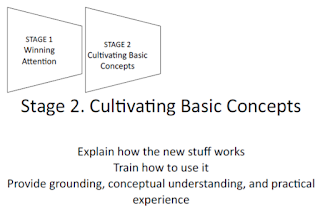This year we had two days full of attendees, from the Netherlands, and even Sweden!
I would like you to get a little peek inside this year's workshop, which was done with a combined total of 48 attendees from 26 different organistions.
Leading for the one-day workshop is his book 'User Adoption Strategies'. Apart from very interesting theory and real life examples from his research and consulting over the past years, there is a strong focus on sharing and learning from eachother. This is why, at the start attendees are asked to not sit next to their colleagues.
Especially during the assignments break-outs this turns out to be very valuable. At several points students are asked to reflect on a user adoption strategy, in varying groups.
Each assignment is around one of the four stages Michael talks about in his book and workshop:
- Winning attention
- Cultivating basic concepts
- Enlivening Applicability
- Making it real
Groups are asked to reflect on the following for their specific chosen user adoption strategy.
Share and discuss your experiences of using the strategy at your work, including when it worked well and when it didn’t work so well. Choose one group member to report back on your discussion. You will have 5-6 minutes to report back. Reporting back should include:
- A quick overview of the strategy.
- Your positive experiences with using the strategy.
- Your warnings about using the strategy.
I will share some of the discussions I overheard in some groups, around the first 3 stages:
Stage 1 ’Winning Attention’
Strategies for winning attention:
- Executive support
- Real-to-life scenarios
- Exemplar stories
- Roadshow
- Organization Chaos
I will talk about the first two strategies.
Strategy 'Executive Support'
The group shares their experiences, sometimes from previous employers, on this strategy, or the absence of it. They all agree executive support should not be 'talking the talk' only, but much more preferable 'walk the walk'.Some examples of this are a video Saxion did for one of their adoption programs, where managers of secretaries and PA's we're being addressed in a collective video by their manager personally. The managers would - all in their own way - declare their support for the program, and their time and energy spent.
Strategy 'Real-to-life scenarios'
The group strongly believes in this scenario. OMROn has used this quite a lot, particularly the scenario smarter meetings. Zorggroep Sint Maartenshares their program for home care nurses who were all involved in buidling their own work scenario. The used something like a whats-app group to be in contact with eachother in an easy way. Since home care nurses are always working privately at client's homes instead of a shared office, being able to share knowledge and experience in a SharePoint teamsiteis important for them.Stage 2 ‘Cultivating basic concepts
Strategies for cultivating basic concepts:
- Classroom training
- Web-based training
- Pages on the intranet
These are the most commonly used strategies, in most organizations. They seem to be a quick and easy way to make great progress in user adoption, but are actually the least effective!
Stage 3 ‘Enlivening Applicability
Strategies for Enlivening Applicability:
- One to One Coaching
- Facilitated Group Re Imagining
- Embedded Champion
- Sandbox for Experimentation
- Easy First Steps
- Build It And They Will Come
I've listened in on the groups discussing the strategies 'Sandbox for experimentation', 'Facilitated group re-imagining' and 'Easy first steps'.
Strategy 'Sandbox for experimentation'
The group compares the sandbox for experimentation to a Proof of Concept. Not surprisingly perhaps, considering the group exists of some IT folks. The key here is, that it is not something, as with a PoC, that is used for measuring success or a go/no go. What is important is that employees feel free to try out things, without the fear of polluting the live system.Strategy 'Facilitated group re-imagining'
All people in the group agree on the importance of keeping an open mind in this strategy.It's about researching possible applicability for a group's actual work. Stimulating to look beyond the way they work now. Coaching in this strategy therefore should not be done with a clear and set goal in mind, but a free-form for the group to explore the possibilities of the new product for their work.With relatively little effort the coach and the group charts their current work (the way we work now). Subsequently they collectively look at possibilities to do it differently, with the new system's functionality (the way we work new).
The group uses this strategy almost like SCRUM, to re-think their work.
One of the pitfalls in this strategy is that the group often wants to achieve a 100% perfect new way of work. Often the old way of working actually wasn't all that perfect. Rather than focussing on a perfect 100% score in the new way of working, it is much better to achive small steps of improvement. An imporvement of 50-70% using the new technology, is a good result, isn't it?
Strategy 'Easy First Steps'
An example is given by a group member where they started with a general training on the functionality of Office 365 / SharePoint online. And this was considered by all to be a complete waste of time. Later on I have been doing a 'Tiny habits' program with them, and also bi-weekly meetings to take on small assignments on particular functionality combined with a work scenario. Because you made a sort of contract with yourself to regularly practice a new behaviour, and reflect on it, you gradually started using functionality (in small steps), and got to experience how this could help you in your daily work.The small assignments and the daily reminders to practice / do something in particular worked really well.



